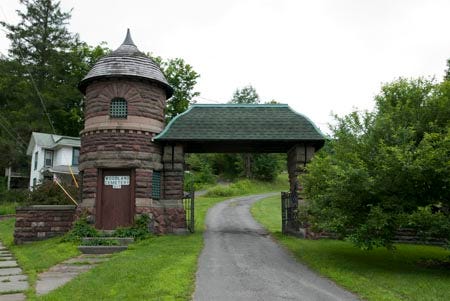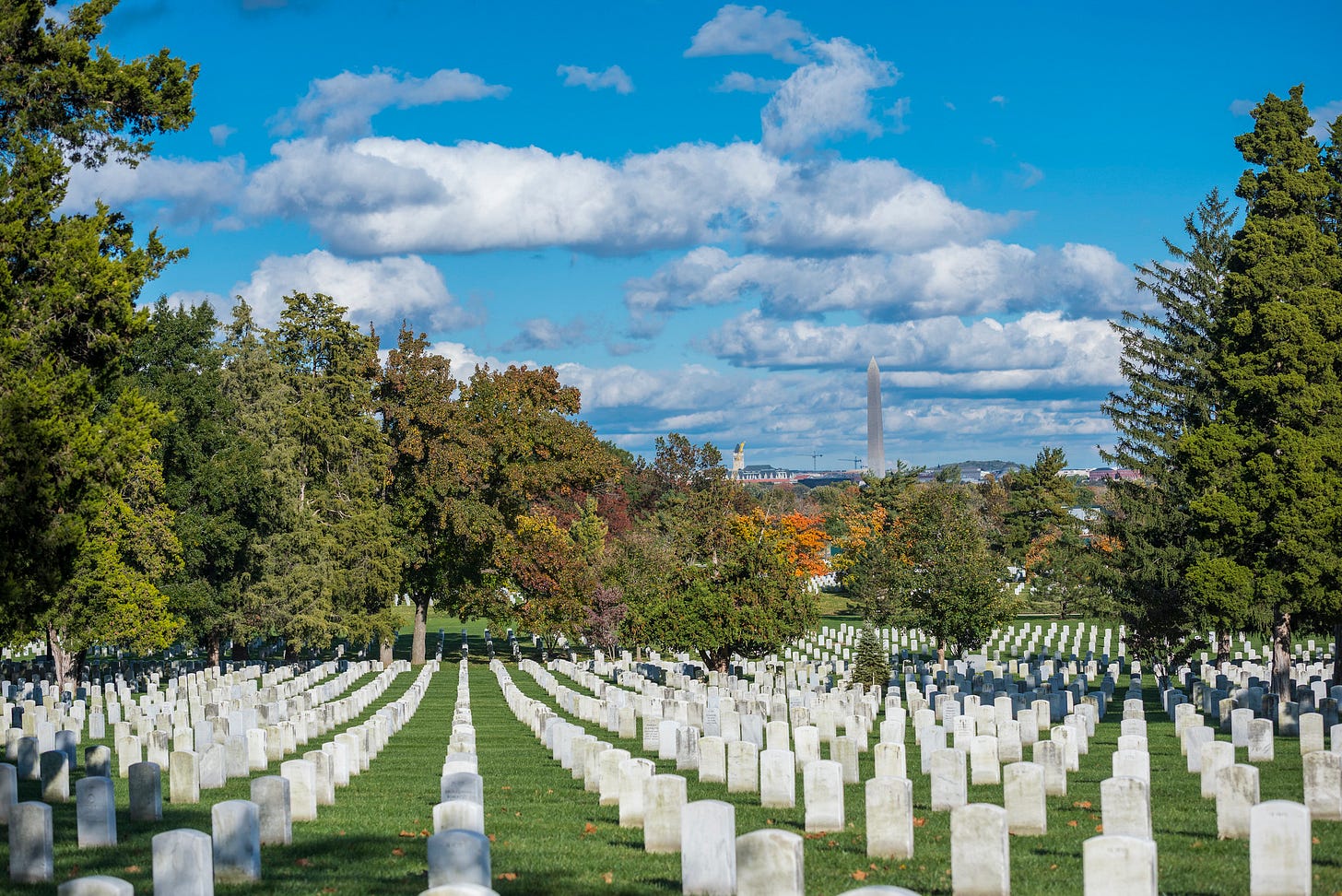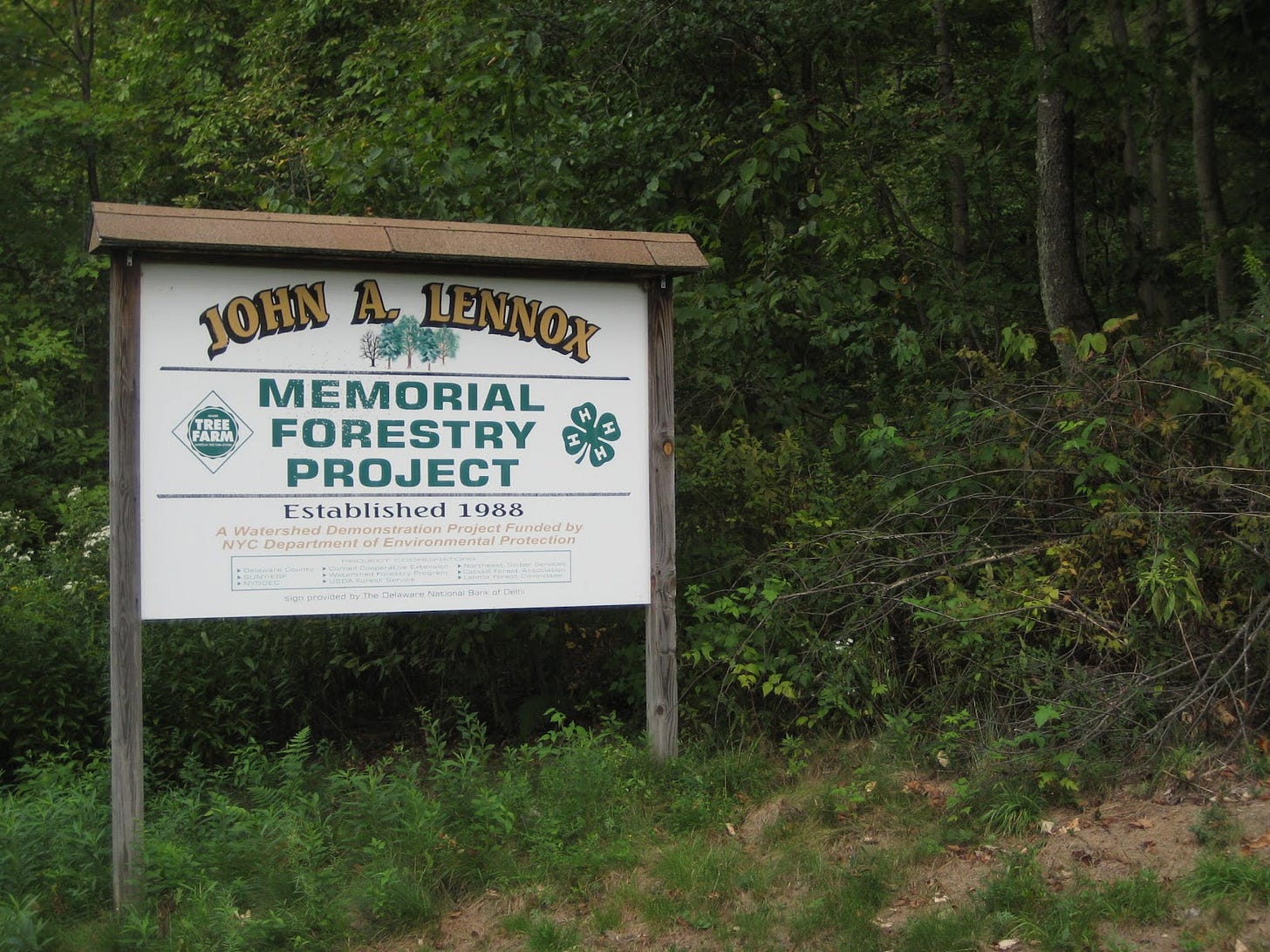An American tradition begins this day, it is the 3 day weekend we call Memorial Weekend, and depending on where you live it is marked with memorial ceremonies at local cemeteries where veterans are interned, parades to honor our veterans, both living and fallen.
Memorial Day Rituals Instilled Respect for Service
When we were far more patriotic and thoughtful people, we treated this day solemnly. My tradition growing up in farm country in upstate New York was that the entire town participated in Memorial Day. The high school marching band would participate in two ceremonies in the county, so we’d arrive early in uniform at the parking lot of the high school, loaded up the equipment van, then clambered aboard buses to head off for the first performance a 30 min ride away at Franklin Cemetery.
Franklin Ouleout Cemetery, Franklin New York
I admit that I haven’t been back to Franklin since I left my home for Michigan. But I am struck by the beauty of the entrance. It is austere - the ornate etchings in that gate don’t jump out at you, there’s no grandeur. But there is a sense of ceremony that requires you set aside thoughts of yourself and reflect on those who have passed on. It may be a resting place, but it is also a place of reflection and honor.
After the ceremony in Franklin we would head back to Delhi to march, ending at the Woodland cemetery for another ceremony. Thinking back on this now, this really was several rituals wrapped up in one day. Woodland was set at the entrance to the village of Delhi on the Route 28, I would pass it every time I’d head to Cooperstown, Oneonta or other destinations. As a kid I became accustomed to seeing it daily, but still, my mind would wander thinking about who was buried there. Having spent some misty days as well as beautiful sunny May days standing at ease wearing a marching drums during speeches, it strikes me now as one the most beautiful landmarks of my youth.
Memorial Day marked the end of marching season for the high school band, our last gathering for the school year. Packing the equipment van was something I had to do each year because being in percussion, we had the most equipment. It was the last time we would wear the marching uniforms for the year as well. And it was that pause before finals and when I’d start work in my dads business full time for the summer. Most businesses were closed in honor of the holiday, except maybe one of the local gas stations. Sure, there were Memorial Weekend sales on Saturday and Sunday, but Monday was a cessation of other facets of life to honor our veterans. To reflect. Things stopped for good reason. On the ride up to school, the streets were quiet and empty, and the build up for the parade and ceremony doesn’t strike me as a loud preamble like Fourth of July parades.
In those days of the early 1980s it was not even questioned that school kids would be expected to bow their heads in prayer for the fallen. I know I am relying on memory, but I can’t recall that anyone from marching would miss that day due to family vacation. It was something I counted on attending, no questions asked. The rituals made it seem like a natural thing to do. It was also a time when I’d see parents or grandparents as veterans, and learn that they had served, or that family members served and did not return. It was what the community did, no thought that people would not participate. Parents would come to honor those who had served.
My father-in-law served in the early 1960s in Passau Germany, where he listened to Russian radio broadcasts for the US Army. It was there he met my future mother-in-law and brought her back to the United States. My father was in ROTC, but was not called to serve in Vietnam. He was at each Memorial Day ceremony though. I vaguely remember the days starting in 1973 as we withdrew from Vietnam, and 1975 more clearly as my parents were disgusted with the “hippie conformists” who so mistreated our returning veterans. “Hanoi Jane” was a term familiar to me. My family understood service to the extent that there was a huge sacrifice that was made. My aunt, only 13 years older than I, so more in tune with the Vietnam era, worked at the VA as a nurse and saw PTSD trauma on a daily basis. Despite that she joined the US Army in the 1980s and ended up at the Presidio in San Francisco. I have a cousin who gave up a career at the Mayo Clinic to serve in Afghanistan as a doctor, and is still with the US Army today. I am in awe of their commitment.
A Brief History of Decoration Day and Memorial Day
The tradition of adorning the graves of the fallen was already a practice in many communities in both north and south. On May 5th 1868 General John Logan, national commander of the Grand Army of the republic, issued General Order 11. The preamble is beautiful:
The 30th day of May, 1868, is designated for the purpose of strewing with flowers or otherwise decorating the graves of comrades who died in defense of their country during the late rebellion, and whose bodies now lie in almost every city, village, and hamlet church-yard in the land. In this observance no form of ceremony is prescribed, but posts and comrades will in their own way arrange such fitting services and testimonials of respect as circumstances may permit.
We are organized, comrades, as our regulations tell us, for the purpose among other things, "of preserving and strengthening those kind and fraternal feelings which have bound together the soldiers, sailors, and marines who united to suppress the late rebellion." What can aid more to assure this result than cherishing tenderly the memory of our heroic dead, who made their breasts a barricade between our country and its foes? Their soldier lives were the reveille of freedom to a race in chains, and their deaths the tattoo of rebellious tyranny in arms. We should guard their graves with sacred vigilance. All that the consecrated wealth and taste of the nation can add to their adornment and security is but a fitting tribute to the memory of her slain defenders. Let no wanton foot tread rudely on such hallowed grounds. Let pleasant paths invite the coming and going of reverent visitors and fond mourners. Let no vandalism of avarice or neglect, no ravages of time testify to the present or to the coming generations that we have forgotten as a people the cost of a free and undivided republic.
If other eyes grow dull, other hands slack, and other hearts cold in the solemn trust, ours shall keep it well as long as the light and warmth of life remain to us.
Let us, then, at the time appointed gather around their sacred remains and garland the passionless mounds above them with the choicest flowers of spring-time; let us raise above them the dear old flag they saved from his honor; let us in this solemn presence renew our pledges to aid and assist those whom they have left among us a sacred charge upon a nation's gratitude, the soldier's and sailor's widow and orphan.
Decoration Day was not issued as an official name until May 30th 1868. Each 30th day of May would be known as Decoration Day. James Garfield, still a representative of Ohio at the time, delivered this address in Arlington Cemetery. I nearly hear the music of trumpets as I read the closing section of his words.
Hither our children's children shall come to pay their tribute of grateful homage. For this are we met to-day. By the happy suggestion of a great society, assemblies like this are gathering at this hour in every State in the Union.
Thousands of soldiers are to-day turning aside in the march of life to visit the silent encampments of dead comrades who once fought by their side. From many thousand homes, whose light was put out when a soldier fell, there go forth to-day to join these solemn processions loving kindred and friends, from whose heart the shadow of grief will never be lifted till the light of the eternal world dawns upon them.
You must consider the context here, as in 1868 the country was still deeply divided over the civil war, yet on this day the fallen soldiers of both Union and Confederate Armies were honored as 5,000 people decorated the graves. A first step in healing.
While an established tradition in most regions, Decoration Dat was not an official national holiday and it would take decades to eventually adopt the practice throughout the union. New York first established Decoration Day in 1873, and 1890 all northern states had adopted the date as well. The south honored their dead on different days until after World War 1 and the honorees included all those who had given their lives in any US war.
Slowly the name Decoration Day became Memorial Day. And in 1971 the last Monday of the month of May was officially designated at Memorial, starting the tradition that most of us are familiar with today.
Arlington Cemetery and Why We Should Keep ALL Statues Standing
Here are some interesting facts about Arlington Cemetery:
There are an average of 25 people buried there daily
Over 400,000 service members are interred at Arlington
The area is over now 639 acres
The acreage belonged to General Lee and was abandoned once he fled Virginia. Lee came into possession of the property by his marriage to Mary Custis Lee. Her father, George Washington Parke Custis, was the adopted grandson of George Washington
Arlington Cemetery was captured by the Union as it strategically overlooks the nation’s capital and within in artillery range.
On June 15, 1864, by order of Secretary of War Edwin Stanton, Arlington was declared are national cemetery.
In 1899 soldiers killed in battle in the Spanish American War were repatriated to US soil and buried in Arlington.
In 1900 an official section for Confederate Soldiers was designated.
Arlington National Cemetery has an important history vital to our understanding of the importance of our history. Yes, merely 3-5% of the South owned slaves, and yes, many joined the Confederates, including Black Americans, to repel the savagery of the Union raids. The Civil War, was fought over state sovereignty, not primarily over slavery. Slavery was a catalyst and a major component of the conflict, but the war was fought over state sovereignty. Many who fought were not fighting to save slavery as a practice, but for what they considered their right to self determination.
We need to consider what could happen to Arlington Cemetery when those who want to erase all trace of racism from our history that Confederate soldiers are buried there, will their fate be the same the General Lee statues? What of those who were associated with Theodore Roosevelt, whose statue was removed from the NYC Museum of Natural History? Honoring the fatalities from both sides of the US Civil War is critical to retain our sense of brotherhood with all Americans - the North and South were able to do this in the late 1800s but somehow we cannot abide by our history and our sacrifice in those wars on both sides? And if indeed there is systematic racism throughout our culture, does that mean that all soldiers interred in Arlington should not be honored? We come dangerously close to fulfilling the wish of removing all memorials for the sake of a clear moderm moral conscience, yet that morality is defined with a twisted set of principles.
Mr Lennox and Respect of Service
I started this article by describing the commitment to honoring service of our country my town had when I grew up. I return with another story from that time, something that taught me the many dimensions of serving during wartime, and the guilt that others had from different eras.
My neighbor, John A Lennox was in his mid 80s and still running his landscaping business when I started working part time for him. Scottish to the core with his clan tartan tie that he wore to dinner each week, Mr Lennox was a fixture in our region, as he and his wife had been involved with 4H for decades. Mr Lennox was responsible for educating many generations through his efforts with 4H at camp Shankitunk, as he was the first director for the camp in 1927. And John Lennox was known as the Christmas Tree Man in Delaware county, owning many acres of trees that I and my buddies trimmed, pruned and harvested for him for the holiday season. Once school started and I would pause working for Dad on his construction crews, and I worked for Mr Lennox after school. In that time heard many of his stories.
The Lennox Model Forest is part of John Lennox’s legacy
Toward the remaining year that I worked for him, Mr Lennox would tell me about his service to our country during the wars. His father was able to get him an exemption from military service in World War I. Instead, Mr Lennox worked for the US Department of Agriculture and was responsible to curation of food supplies from farmers up and down the Hudson River Valley. He did this in World War I and World War II, delivering supplies on a weekly basis to the docks in New York City. That is great service, it was an amazing job that he did.
But whenever he told this story, he would begin to weep. He harbored an overwhelming guilt for not having been in the Army and overseas while his friends had served in the during the wars. He and his wife were wonderful people, were without children, yet they had served so many families with their dedication to 4H, having founded a large camp in our county that operated for decades. He supplied the troops with food, a very vital task. Yet he harbored this guilt. For me that demonstrated what a solemn duty service to our country in a time of war meant, and how it was regarded by earlier generations.
We live very different lives today, and sadly we equate freedom with the lack of responsibility and duty. I took a bike ride through the cemetery where I live, hopefully you watched the video. It gives me great hope, but it also saddens me. That spirit that honors service to our country lives still, but are we still devoted enough to those ideals, or are we too comfortable that sales and kicking off summer has been adopted as the true meaning of this time when we should practice remembrance? We would perhaps have a different set of problems today if our patriotism were stronger as they were when I was growing up. My children have those values, but do enough of we adults require a demonstration of those virtues, and have we replaced healthy rituals with rituals of a different sort that help hide our history?










